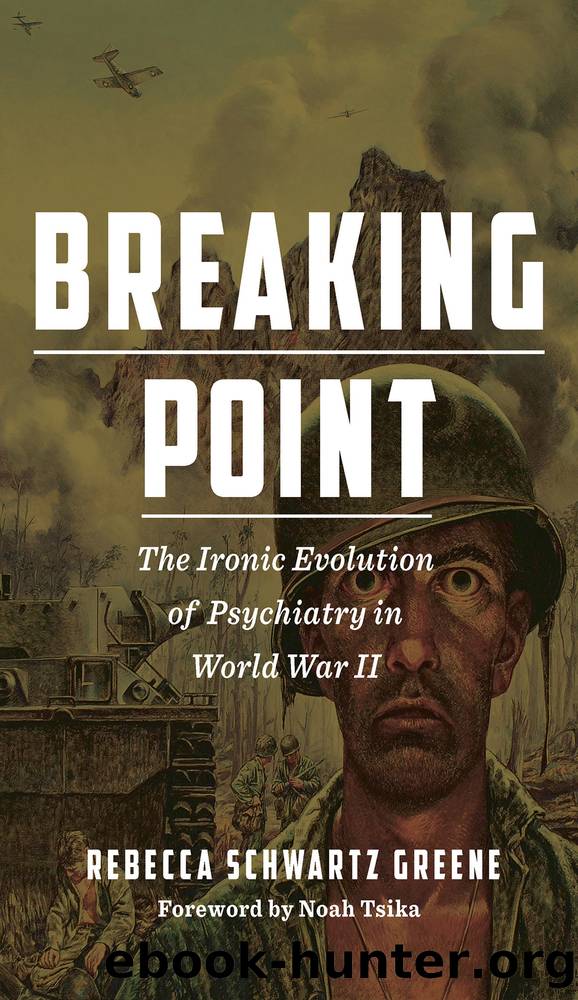Breaking Point by Rebecca Schwartz Greene;

Author:Rebecca Schwartz Greene;
Language: eng
Format: epub
Publisher: Fordham University Press
PTSD
As did Menninger, many psychiatrists shied away from recognizing that soldiers with war experience might sustain long-term, even permanent debilitating illness, despite significant numbers exhibiting symptoms later termed PTSD. First enumerated in the third edition of the APAâs Diagnostic and Statistical Manual of Mental Disorders (1980), or DSM-III, the criteria included a âstressor,â that is, a traumatic occurrence beyond the individualâs usual experiences. The stressor had to be a rape, torture, a natural disaster, an airplane crash, or, in the case of veterans, combat. The stressor would cause symptoms within six months of the date of trauma (âacuteâ) or later on (âchronic or delayedâ). The primary symptoms included reliving the traumatic past in oneâs mind through flashbacks, dreams, or an association with a similar, current incident and withdrawal from social or sexual activity, along with other possible symptoms, including difficulty sleeping, exaggerated startle reaction, guilt about surviving, the death of someone close, memory impairment, avoiding events that reminded him or her about the trauma or, on the other hand, intensifying the symptoms by exposure to events that resembled the original stressor.21
Many from World War II had characteristics of PTSD, though it was not then recognized: They withdrew from social or sexual contact, especially in their first year home. They replayed the trauma in their minds continuously. They carried guns or knives as if still in combat. They avoided memories of combat by binging on drugs or, more frequently, alcohol. (Over 750,000 veterans were alcoholics, at a treatment cost of $750 million annually by 1947, according to Menninger. Two years later, it came close to $780 million.)22 They had suicidal or homicidal thoughts. Noise, smells, or food could trigger recollection of the trauma.23
The first studies of prisoners of war returning from Japan pointed to detachment and loss of sexual interest. By 1947, extensive psychiatric examination of thirty-five Americans subjected to three years of torture in Japanese prison of war camps found widespread mental changes. Half had impaired memory. Eight were psychopathic. Follow-ups six months and a year later revealed continuing alarm reactions, nightmares, and, particularly, distrust of others. A six-year study in 1954 found continuing psychoneuroses and psychosis among thousands of Pacific POWs, with symptoms resembling PTSD. Robert Keehnâs 1974 study of almost ten thousand psychoneurotic veterans and ten thousand controls found that psychoneurotics, twenty-six to thirty years old in 1944, who had served at least ninety days, had higher rates of homicide, suicide, alcoholism, and suicide-prone accidents, especially accidental drowning, than their normal counterparts.24 Though PTSD was not yet an official diagnosis, the media recognized behavior resembling PTSD. In one episode of the television series Streets of San Francisco (1973), a police detective, played by a young Michael Douglas, sympathetically protected a reclusive âschizoidâ navy veteran, who suffered with a disability incurred from seeing all his men go down during the Japanese bombing of the battleship Oklahoma at Pearl Harbor.25
Once PTSD became official, World War II veterans were diagnosed, and, forty, fifty, even sixty or seventy years after the war,
Download
This site does not store any files on its server. We only index and link to content provided by other sites. Please contact the content providers to delete copyright contents if any and email us, we'll remove relevant links or contents immediately.
Through Windows of Opportunity : A Neuroaffective Approach to Child Psychotherapy by Marianne Bentzen; Susan Hart(891)
Overcoming ADHD Without Medication : A Guidebook for Parents and Teachers by Children and Natural Psychology Association for Youth; Children The Association for Youth(829)
Out of the Mainstream: Helping the Children of Parents with a Mental Illness by Loshak Rosemary;(823)
Delphi Collected Works of Sigmund Freud (Illustrated) by Sigmund Freud(584)
The Noom Mindset by Noom(557)
The 48 Laws of Mental Power: Overcoming Trauma and Building Mental Strength by Victor O. Carl(490)
The Psychology of Media and Politics by George Comstock & Erica Scharrer(454)
MANIPULATION & MIND CONTROL: The Persuasion Collection: Dark Psychology Secrets, Analyze & Influence People with Nlp. How to learn Reading Friends and Develop Body Language Skills. by ROBERT TOWER(442)
Sigmund Freud by Janet Sayers;(419)
It's nobody's fault: new hope and help for difficult children and their parents by Harold Koplewicz(409)
Behold the Monster by Jillian Lauren(409)
The Hypnotic Coach: A Conversational Hypnotherapy Tool Kit by Marion Jess(398)
Directions in Technical Writing and Communication by Gould Jay R.;(388)
THE PSYCHOLOGY OF ENTREPRENEURSHIP; New Perspectives by Michael M. Gielnik; Melissa S. Cardon; Michael Frese(366)
Mastering Flow: Perform Better, Experience More Joy, and Live a Happier Life by Nils Salzgeber(356)
Totem and Taboo: Some Points of Agreement between the Mental Lives of Savages and Neurotics by Sigmund Freud(350)
Positive Psychology Across the Lifespan; An Existential Perspective by Piers Worth(340)
Mind Hacking Secrets and Unlimited Memory Power: 2 Books in 1: Learn How to Improve Your Memory & Develop Fast, Clear Thinking in 2 Weeks + 42 Brain Training Techniques & Memory Improvement Exercises by Sharp Scott(339)
The Modern Young Man's Guide to Manhood by Wayne Walker(330)
